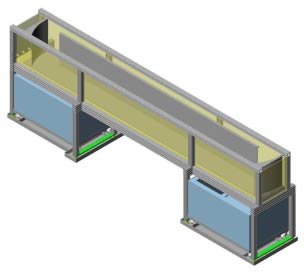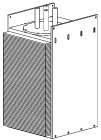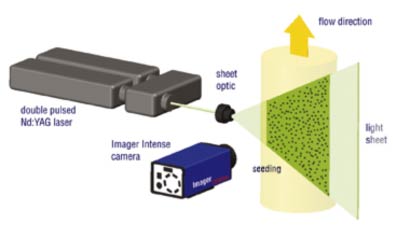Facilities
The ENDLab is comprehensively equipped for laboratory studies of stratified flows, internal waves and nonlinear dynamics. Here is a brief overview of our facilities.
Wave Tanks

(i) The large tank
This tank was constructed in 2006 through funding provided by the ONR NLIWI program. It is 5.5 meters long, 0.5 meters wide and 0.6 meters high. There is a partition that runs the length of the tank splitting it into 0.35 m and 0.15 m sections. Experiments are performed in the wider section and parabolic reflection barriers at either end direct the wave field into the narrower section, where it is dissipated. This prevents wave reflections coming back into the field of view, and the tank behaves as if it were infinitely long.
The glass wave tank is filled using a computer-controlled pumping system run via two peristaltic pumps, enabling us to set up nonlinear density stratifications. A Labview based motion-control system is used to drive side-to-side motion of the topography mounted from above on a lead screw traverse, to simulate baratropic tidal motion. This motion need not be simple sinusoidal motion, but can be a complex signal used to represent complex tidal forcing. Optical access is from all four sides, and the central working section is 2.5 meters long.
(ii) The medium tank
This acrylic tank measures 1.3 meters long, 0.2 meters wide and 0.7 meters high. It has been used for a number of fundamental internal wave studies, such as nonlinear effects in internal wave beam reflection and internal wave generation by canonical topographic features. A pulley system mounted on an 8020 support frame around the tank is used to drive oscillations of topographic features in the tank. This tank is primarily used for preliminary studies of fundamental phenomena, before being scaled up to the large tank.
(iii) The smaller tanks
We have two smaller acrylic tanks. The first is 0.7 meters long, 0.5 meters wide and 0.5 meters high. A key feature of this tank is that it is configured for the placement of false walls that allow its horizontal dimensions to be varied. This is important for stratified flow experiments where the influence of horizontal sidewalls needs to be clearly established. It has filling ports in the base of two corners and a separate draining port in the base.
The oldest and smallest tank in our lab is 0.4 meters long, 0.3 meters wide and 0.4 meters high, and dates back to the foundation of the lab in 2003. Whilst small, this work horse is beautifully set up for establishing density stratifications and implementation of the Synthetic Schlieren technique, and has produced new experimental results for propulsion through diffusion, settling particles and layering in stratified fluids. We are sure there is still more to come from this little guy in the years ahead.
Wave Generator

A standout piece of equipment in the ENDLab for internal wave studies is a version of the novel wave generator conceived by Gostiaux & Dauxois (2007). A series of flat plates stacked on an eccentric camshaft is use to set the spatial form of the wave field. The frequency of forcing is controlled by the rotational speed of the driving motor. Our generator is particularly highly resolved, standing 0.534 m high and 0.3 m wide, with 82 plates of thickness 6.3 mm. This generator can be used to create wave beams, plane waves and discrete vertical modes (even in a nonuniform stratification). The wave tank is configured for easy mounting of the wave generator, which can be positioned at one end of the wave tank or at the end of the central working section of the wave tank.
Measurement Technology

Particle Image Velocimetry
The ENDLab has extensive Particle Image Velocimetry (PIV) capabilities to measure flow velocity fields through a comprehensive LA Vision system. This comprises two Imager Pro X4 CCD Cameras with 2GB on-board memory for planar and stereo PIV; dual p4 processor PC; DaVis software; Big Sky Ultra Nd:Yag 120 mJ/pulse laser; adjustable light-sheet optics; computer-controlled traverse with integrated camera-focus adjust for systematic slicing of velocity fields.
Laser Induced Fluorescence
The LA vision system can also be employed for either individual density-field measurements via Laser Induced Fluorescence (LIF) or for simultaneous PIV/LIF studies. Additional equipment for the LIF includes automatic recording of laser pulse intensity, for improved measurement accuracy.
Synthetic Schlieren
Our Synthetic Schlieren system utilizes a JAI CV-M4+CL CCD camera, which is operated using Digiflow software, generously provided by Stuart Dalziel at the University of Cambridge. Backlighting of the random pattern of dots is obtained using an electroluminescent sheet. A thermal tunnel is used to reduce the thermal noise in the system. A Dell Precision 650 Desktop is used for storing images and processing using Digiflow. The raw data obtained using this technique is the density gradient perturbation in both the horizontal and vertical direction for two-dimensional and axisymmetric flows.
Conductivity & Temperature Probes
The ENDLab possesses several PME conductivity and temperature probes. These probes are calibrated for density using temperature controlled samples, whose density is measured using an Anton-Parr DMA38 densitometer, and whose temperature is measured using a thermometer accurate to 0.01 degree centigrade.
Control Technology

Thermal Chamber
For experiments that require a high-degree of thermal control there is a dedicated, insulated thermal chamber which has a square 1 meter by 1 meter base, and stands 1.7 meters tall. The entire chamber stands 1 meter off the ground and is supported by an 8020 support frame, as well as having 8020 frame mounted on the inside. This allows for traverses, cameras and optical elements for PIV visualization (and other methods) to be mounted for experimental investigations. There is optical axis to the center of the chamber from three of the four sidewalls and from below. The uniform temperature throughout the chamber can be controlled to within 0.1 degrees using an EIC heating/cooling unit with PID control.

Thermal baths
A pair of Thermoelectron/Neslab/Haake thermal baths are used for temperature control of fluid samples. These are typically used in the range 15-30 degrees Celsius for our experiments, for careful control of the calibration samples for the PME density probe.

Pumps
The lab possesses a pair of Masterflex IP peristaltic pumps, which are capable of flow rates in the range 0.1 to 30 LPM. The pumps can be readily computer-controlled and form the basis of our double-bucket stratification system.

Motion Control
Two Labview-based systems are used for motion control and data acquisition in the lab. We have several Parker lead-screw traverses ranging from 1.5 meters down to 0.3 meters long. All the traverses are operated using stepper motors and have feedback control.



